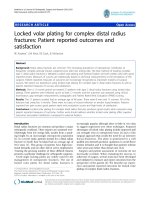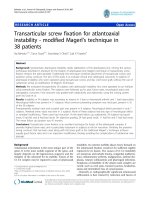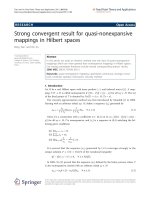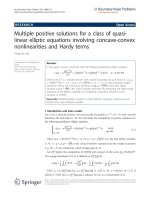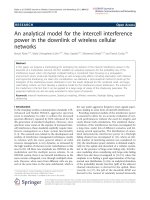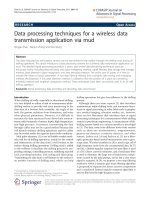Báo cáo hóa học: "AN EXISTENCE RESULT FOR A MULTIPOINT BOUNDARY VALUE PROBLEM ON A TIME SCALE" potx
Bạn đang xem bản rút gọn của tài liệu. Xem và tải ngay bản đầy đủ của tài liệu tại đây (488.57 KB, 8 trang )
AN EXISTENCE RESULT FOR A MULTIPOINT BOUNDARY
VALUE PROBLEM ON A TIME SCALE
BASANT KARNA AND BONITA A. LAWRENCE
Received 31 January 2006; Revised 15 April 2006; Accepted 19 April 2006
We wil l expand the s cope of application of a fixed point theorem due to Krasnosel’ski
˘
ı
and Zabreiko to the family of second-order dynamic equations described by u
ΔΔ
(t) =
f (u
σ
(t)), t ∈ [0,1] ∩ T, with multipoint boundary conditions u(0) = 0, u(σ
2
(1)) =
n
i
=1
α
i
u(η
i
), and
n
i
=1
α
i
≤ 1 for the purpose of establishing existence results. We will de-
termine sufficient conditions on our function f such that the assumptions of the fixed
point theorem are satisfied, which in return gives us the existence of solutions.
Copyright © 2006 B. Karna and B. A. Lawrence. This is an open access article distributed
under the Creative Commons Attribution License, which permits unrestr icted use, dis-
tribution, and reproduction in any medium, provided the original work is properly cited.
1. Introduction
Consider a very general family of dynamic equations of the form
u
ΔΔ
(t) = f
u
σ
(t)
, t ∈ [0,1] ∩ T, (1.1)
a second-order dynamic equation defined on a time scale,
T, that is a subset (closed by
definition) of the interval [0,1]. (For more information on time scales calculus, see the
books of Bohner and Peterson [4, 5]andHilger[12].) Assume that you know the behavior
of the solution at an initial value as well as the relationship between the values of the
solution at several other points. In particular, let us consider boundary conditions
u(0)
= 0, u
σ
2
(1)
=
n
i=1
α
i
u
η
i
,
n
i=1
α
i
≤ 1, (1.2)
where η
i
∈ [0,1] ∩ T. A standard method for establishing the existence of solutions for
such dynamic boundary value problems is the application of a fixed point theorem. Many
Hindawi Publishing Corporation
Advances in Difference Equations
Volume 2006, Article ID 63208, Pages 1–8
DOI 10.1155/ADE/2006/63208
2 Existence of positive solution
such theorems such as Guo-Krasnosel’ski
˘
ı found in [8], Leggett-Williams [15], and, more
recently, Avery-Henderson [3] have been used to develop the various existence results
currently available to us. The particular fixed point theorem used determines the cor-
responding assumptions on the function f in (1.1) that will insure the existence. For
example, using the fixed point theorems described above, the existence of positive solu-
tions for (1.1) with various types of boundary conditions has been established in the case
when f>0. (See Anderson [1, 2] and Erbe and Peterson [6, 7].)
Sun and Li [16]tookadifferent track that allowed the function f in (1.1)tochange
sign. The basis of their proof was a fixed point theorem due to Krasnosel’ski
˘
ıandZabreiko
and they assumed right focal boundary conditions. In [10], Henderson expanded their
result to mixed b oundary conditions
αu(0)
− βu
Δ
(0) = 0,
γu
σ
2
(1)
+ δu
Δ
σ(1)
=
0,
(1.3)
for α,β,γ,δ>0, and
d
= γβ+ αδ + αγσ
2
(1) > 0. (1.4)
In [11] Henderson and Lawrence investigated higher even-ordered problems with Sturm-
Liouville boundary conditions using this result of Krasnosel’ski
˘
ı and Zabreiko. In this
paper, we return to the second-order problem and allow for multiple boundary points.
First, in Section 2 we lay the foundation for the development of our theorem by stating
the fixed point theorem and analyzing its required elements. In Section 3,wedetermine
what the assumptions of the fixed point theorem imply about our dynamic equation and
complete the paper with a statement of our existence theorem in Section 4.
2. Foundational results
Our main result is an application of the fixed point theorem due to Krasnosel’ski
˘
ıand
Zabreiko that follows in its original form. The assumptions of this theorem include two
operators; one completely continuous and asymptotically linear and one bounded and
linear, and a Banach space to work in. For our particular application, the operators are
defined in terms of an appropriate Green’s function.
Theorem 2.1. Let E be a Banach space and F a completely continuous operator defined on
all of E which is asymptotically linear. If 1 is not an eigenvalue of the operator F
(∞), then
x
= Fx hasatleastonesolution.
The notation F
(∞), the derivative of F at infinity, denotes a linear operator A that
satisfies
lim
x→∞
Fx− Ax
x
=
0. (2.1)
B. Karna and B. A. Lawrence 3
If such an operator A exists, the oper ator F is called asymptotically linear. The basis
of the proof of this far-reaching theorem (found in [13]) is the following. With no eigen-
value of 1, x
− F(x)andx − A(x) are of the same homotopy class and therefore have the
same index.
Our Banach space of choice is (X,
·), where X = C[0,σ
2
(1)] and
u=sup
u(t)
t ∈
0,σ
2
(1)
. (2.2)
We will construct two required operators using Green’s function for the homogeneous
equation
−u
ΔΔ
(t) = 0, t ∈ [0,1] ∩ T, (2.3)
with boundary conditions (1.2). This requires the construction of a general Green’s func-
tion for (2.3)withn + 2 boundary points that satisfy the conditions laid out in (1.2). To
clean up the notation a bit, define α and T as
α
≡ 1 −
n
i=1
α
i
,
T
≡ σ
2
(1) −
n
i=1
α
i
η
i
.
(2.4)
Green’s function is piecewise defined as follows:
(i) for t
≤ s and 0 ≤ s ≤ η
1
,
G(t,s)
= t
1 −
σ(s)α
T
, (2.5)
and for σ(s)
≤ t and 0 ≤ s ≤ η
1
,
G(t,s)
= σ(s)
1 −
tα
T
; (2.6)
(ii) for t
≤ s and σ(η
1
) ≤ s ≤ η
2
,
G(t,s)
= t
1+
1
T
1
i=1
α
i
σ
η
i
−
σ(s)
−
σ(s)α
, (2.7)
and for σ(s)
≤ t and σ(η
1
) ≤ s ≤ η
2
,
G(t,s)
= σ(s)+
t
T
1
i=1
α
i
σ
η
i
−
σ(s)
−
σ(s)α
; (2.8)
(iii) for t
≤ s and σ(η
2
) ≤ s ≤ η
3
,
G(t,s)
= t
1+
1
T
2
i=1
α
i
σ
η
i
−
σ(s)
−
σ(s)α
, (2.9)
4 Existence of positive solution
and for σ(s)
≤ t and σ(η
2
) ≤ η
3
,
G(t,s)
= σ(s)+
t
T
2
i=1
α
i
σ
η
i
−
σ(s)
−
σ(s)α
; (2.10)
(iv) and finally, for t
≤ s and σ(η
n
) ≤ s ≤ σ
2
(1) ≡ η
n+1
,
G(t,s)
=
t
T
σ
2
(1) − σ(s)
, (2.11)
and for σ(s)
≤ t and σ(η
n
) ≤ s ≤ σ
2
(1) ≡ η
n+1
,
G(t,s)
= σ(s)+t
σ
2
− σ(s)
T
− 1
. (2.12)
In general, this Green’s function can be written in closed form as follows:
G(t,s)
=
⎧
⎪
⎪
⎪
⎪
⎪
⎪
⎨
⎪
⎪
⎪
⎪
⎪
⎪
⎩
t
1+
1
T
k
i=1
α
i
σ
η
i
−
σ(s)
−
σ(s)α
if t ≤ s, σ
η
k
≤
s ≤ η
k+1
,
σ(s)+
t
T
k
i=1
α
i
σ
η
i
−
σ(s)
−
σ(s)α
if σ(s) ≤ t, σ
η
k
≤
s ≤ η
k+1
,
(2.13)
where k
= 0,1, ,n, η
0
= 0, η
n+1
= σ
2
(1), and for k = 0,
k
i
=1
α
i
(σ(η
i
) − σ(s)) = 0.
Note that from the assumptions we have made on the boundar y points and the defi-
nition of G(t,s) above we have G(t,s) > 0for(t,s)
∈ (0,σ
2
(1)) × (0,σ(1)).
With this Green’s function in mind, we define our completely continuous operator,
F : X
→ X:
(Fu)(t) =
σ(1)
0
G(t,s) f
u
σ
Δs. (2.14)
Thechoiceismadebecauseitiswellknownthatu is a fixed point of F ifandonlyifu is
asolutionof(1.1), (1.2). Next consider the linear dynamic equation
u
ΔΔ
(t)+mu
σ(t)
=
0, t ∈ [0,1] ∩ T, (2.15)
satisfying conditions (1.2). We know that solutions of this multipoint problem are fixed
points of the bounded linear operator
(Au)(t)
= m
σ(1)
0
G(t,s)u
σ(s)
Δs, (2.16)
where G(t,s) is Green’s function for (2.3) satisfying (1.2). Hence, this operator is the op-
erator A required by the fixed point theorem.
B. Karna and B. A. Lawrence 5
3. A motivation of the main result
With the operators F and A in mind, we must first verify that 1 is not an eigenvalue for
the operator A. In the process we w ill discover the nature of our constant m in (2.15). In
the trivial case, when m
= 0, the only solution of (2.15), (1.2) is trivial and t herefore A
does not have 1 for an eigenvalue. In the event that m
= 0 and using the definition of the
operator and properties of inequalities we have the following estimate:
Au= sup
t∈[0,1]∩T
m
σ(1)
0
G(t,s)u
σ
(s)Δs
=|
m| sup
t∈[0,1]∩T
σ(1)
0
G(t,s)u
σ
(s)Δs
≤|
m| sup
t∈[0,1]∩T
σ(1)
0
G(t,s)
u
σ
(s)
Δs
≤|m|u sup
t∈[0,1]∩T
σ(1)
0
G(t,s)Δs.
(3.1)
Now if we choose m such that
m<b
=
1
sup
t∈[0,1]∩T
σ(1)
0
G(t,s)Δs
, (3.2)
then the above expressions reduce to
Au <bu
1
b
=u, (3.3)
and 1 is not an eigenvalue of A.
The next important question we need to answer is the following: what is needed to
insure that the limit in the assumptions of the fixed point theorem, that is,
lim
x→∞
Fx− Ax
x
=
0 (3.4)
will be satisfied? Consider first the numerator of this expression, and utilizing the nature
of G we have
F(u) − A(u)
=
sup
t∈[0,1]∩T
m
σ(1)
0
G(t,s)
f
u
σ
(s)
−
mu
σ
(s)
Δs
≤
sup
t∈[0,1]∩T
m
σ(1)
0
G(t,s)
f
u
σ
(s)
−
mu
σ
(s)
Δs.
(3.5)
We need to show that we can bound this last expression by
ε
·u·K,whereK is a positive constant, (3.6)
6 Existence of positive solution
for any ε>0. One method for arriving at this end would be to show that
f
u
σ
(s)
−
mu
σ
(s)
<εu. (3.7)
We make the assumption that our function f in (1.1) satisfies the following limit:
lim
r→∞
f (r)
r
= m, (3.8)
where m is defined in (3.2). Choose any ε>0. The proceeding limit insures us that we can
find a constant C
1
> 0 such that when r >C
1
,
f (r) − mr
<ε|r|. (3.9)
Using this constant C
1
, we calculate another constant C defined as
C
= sup
|r|≤C
1
f (r)
, (3.10)
and note that for u
σ
(s) ≤ C
1
and for s ∈ [0, σ(1)] ∩ T,
f
u
σ
(s)
−
mu
σ
(s)
≤
f
u
σ
(s)
+ |m|
u
σ
(s)
≤
C + |m|C
1
. (3.11)
Also, we can find M>C
1
large enough so that
C +
|m|C
1
<M· ε, (3.12)
and therefore, if we choose u
∈ X such that u >Mour expression (3.11)reducesto
f
u
σ
(s)
−
mu
σ
(s)
≤
εM ≤ εu. (3.13)
For the case when u
σ
(s) >C
1
, condition (3.8) gives us the same bound
f
u
σ
(s)
−
mu
σ
(s)
≤
ε
u
σ
(s)
≤
εu. (3.14)
So, for all u such that
u >M, we have the desired bound for the nor m of the differ-
ence of F and A,
F(u) − A(u)
=
sup
t∈[0,1]∩T
m
σ(1)
0
G(t,s)
f
u
σ
(s)
−
mu
σ
(s)
Δs
≤
εu sup
t∈[0,1]∩T
m
σ(1)
0
G(t,s)Δs
<ε
u
1
b
,
(3.15)
or equivalently, our limit holds:
lim
x→∞
Fx− Ax
x
=
0. (3.16)
We now have created the requisite operators and determined conditions on f in (3.8)
that will insure that the prescribed limit holds. Next we have, the existence theorem.
B. Karna and B. A. Lawrence 7
4. Existence theorem
The motivation in Section 3 gives rise to the our main result.
Theorem 4.1. Let f :
R → R be a continuous function such that
lim
u→∞
f (u)
u
= m. (4.1)
If
1
sup
t∈[0,1]∩T
σ(1)
0
G(t,s)Δs
= b>|m|, (4.2)
then the nonlinear boundary value problem (1.1), (1.2)hasasolution.
Proof. Assume that f satisfies condition (4.1) and that the value m satisfies (4.2). For
the prescribed operators, F and A, use the operator defined in (2.14)and(2.16), respec-
tively. In Section 3 we verified that A does not have 1 as an eigenvalue and that, w ith the
conditions on f , the limit
lim
x→∞
Fx− Ax
x
=
0 (4.3)
holds. The theorem of Krasnosel’ski
˘
ıandZabreikotellsusthatF has a fixed point, that is,
y(t)
=
σ(1)
0
G(t,s) f
y
σ
(s)
Δs (4.4)
is a solution of (1.1), (1.2).
The use of this fixed point offers us the opportunity to consider functions that change
sign. While this expands the class of functions that can be considered, one must keep
in mind the additional assumptions on f . The crux of the matter is determining the
associated Green’s function necessary to define the operators. The authors are currently
considering even ordered mixed derivatives such as
∇Δ, Δ∇, and so forth.
References
[1] D. R. Anderson, Eigenvalue intervals for a second-order mixed-conditions problem on time scales,
International Journal of Nonlinear Differential Equations 7 (2002), no. 1-2, 97–104.
[2]
, Eigenvalue intervals for a second-order Sturm-Liouville dynamic equations, to appear in
International Journal of Nonlinear Differential Equations.
[3] R.I.AveryandJ.Henderson,Two positive fixed points of nonlinear operators on ordered B anach
spaces, Communications on Applied Nonlinear Analysis 8 (2001), no. 1, 27–36.
[4] M. Bohner and A. Peterson, Dynamic Equations on Time Scales. An Introduction with Applica-
tions,Birkh
¨
auser Boston, Massachusetts, 2001.
[5] M. Bohner and A. Peterson (eds.), Advances in Dynamic Equations on Time Scales,Birkh
¨
auser
Boston, Massachusetts, 2003.
[6] L.H.ErbeandA.C.Peterson,Eigenvalue conditions and positive solutions,JournalofDifference
Equations and Applications 6 (2000), no. 2, 165–191.
8 Existence of positive solution
[7] , Positive solutions for a nonlinear differential equation on a measure chain, Mathematical
and Computer Modelling 32 (2000), no. 5-6, 571–585.
[8] D. J. Guo and V. Lakshmikantham, Nonlinear Problems in Abstract Cones, Notes and Reports in
Mathematics in Science and Engineering, vol. 5, Academic Press, Massachusetts, 1988.
[9] J. Henderson, Multiple solutions for 2mth order Sturm-Liouville boundary value problems on a
measure chain,JournalofDifference Equations and Applications 6 (2000), no. 4, 417–429.
[10]
, Nontrivial solutions to a nonlinear boundary value problem on a time scale, Communi-
cations on Applied Nonlinear Analysis 11 (2004), no. 1, 65–71.
[11] J. Henderson and B. A. Lawrence, Existence of solutions for even ordered boundary value problems
on a t ime scale, Proceedings of the International Conference on Difference Equations, Special
Functions, and Applications, Munich, 2006.
[12] S. Hilger, Ein Masskettenkalk
¨
ul mit Anwendung auf Zentrumsmannigfaltigkeiten, Ph.D. thesis,
Universit
¨
at W
¨
urzburg, W
¨
urzburg, 1988.
[13] M. A. Krasnosel’eski
˘
ı a n d P. P. Zab re
˘
ıko, Geometrical Methods of Nonlinear Analysis, Fundamen-
tal Principles of Mathematical Sciences, vol. 263, Springer, Berlin, 1984.
[14] V. Lakshmikantham, S. Sivasundaram, and B. Kaymakc¸alan, Dynamic Systems on Measure
Chains, Mathematics and Its Applications, vol. 370, Kluwer Academic, Dordrecht, 1996.
[15] R. W. Leggett and L. R. Williams, Multiple positive fixed points of nonlinear operators on ordered
Banach spaces, Indiana University Mathematics Journal 28 (1979), no. 4, 673–688.
[16] J P. Sun and W.T. Li, A new existence theorem for right focal boundary value problems on a measure
chain,AppliedMathematicsLetters18 (2005), no. 1, 41–47.
Basant Karna: Department of Mathematics, Marshall University, Huntington, WV 25755, USA
E-mail address:
Bonita A. Lawrence: Department of Mathematics, Marshall University, Huntington, WV 25755, USA
E-mail address:



